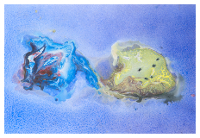Conveners
Parallel II: B4 Light Quarks
- Jose Luis Goity (Hampton University/Jefferson Lab)
Gilberto Colangelo
(Bern University)
09/09/2014, 14:00
Section B: Light Quarks
I will describe our recent dispersive analysis of the hadronic light-by-light tensor. We relate the latter to the helicity amplitudes of the process $\gamma^* \gamma^* \to \pi \pi$ and provide a formula for the calculation of the hadronic light-by-light contribution to $(g-2)_\mu$.
Dr
Marc KNECHT
(CNRS - CPT Marseille)
09/09/2014, 14:30
Section B: Light Quarks
Isospin breaking in the $K_{\ell 4}$ form factors induced by the difference between charged and
neutral pion masses is discussed within a framework built on suitably subtracted dispersion representations. The $K_{\ell 4}$ form factors are constructed in an iterative way up to two loops in the low-energy expansion by implementing analyticity, crossing, and unitarity due to two-meson...
Dr
Jan (for the COMPASS collaboration) Friedrich
(CERN / TU Munich)
09/09/2014, 15:00
Section B: Light Quarks
With the COMPASS experiment at CERN, pion-photon reactions are investigated
via the Primakoff effect, implying that high-energetic pions react with the
quasi-real photon field surrounding the target nuclei.
The production of a single hard photon in such a pion scattering,
at lowest momentum transfer to the nucleus, is related to pion Compton
scattering. From the measured ...
Andrei Alexandru
(The George Washington University, USA)
09/09/2014, 15:30
Section B: Light Quarks
Electromagnetic polarizabilities are important parameters for understanding the interaction
between photons and hadrons. For pions these quantities are poorly constrained experimentally since they can only be measured indirectly. New experiments at CERN and Jefferson Lab are planned that will measure the polarizabilities more precisely. Lattice QCD can be used to compute these quantities...
